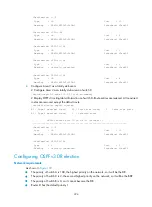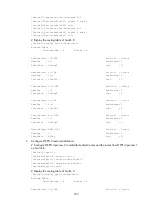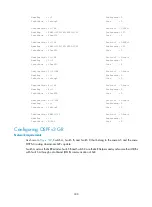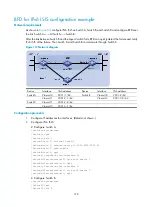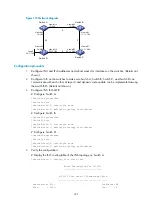
308
OSPFv3 packets between Switches A, B, and C are protected by IPsec.
Troubleshooting OSPFv3 configuration
No OSPFv3 neighbor relationship established
Symptom
No OSPF neighbor relationship can be established.
Analysis
If the physical link and lower protocol function properly, verify OSPF parameters configured on interfaces.
The two neighboring interfaces must have the same parameters, such as the area ID, network segment
and mask, and network type. If the network type is broadcast, at least one interface must have a DR
priority higher than 0.
Process steps
1.
Use the
display ospfv3 peer
command to display neighbor information.
2.
Use the
display ospfv3 interface
command to display OSPFv3 interface information.
3.
Ping the neighbor router's IP address to verify connectivity.
4.
Verify OSPF timers. The dead interval on an interface must be at least four times the hello interval.
5.
On a broadcast network, at least one interface must have a DR priority higher than 0.
Incorrect routing information
Symptom
OSPFv3 cannot find routes to other areas.
Analysis
The backbone area must maintain connectivity to all other areas. If a router connects to more than one
area, at least one area must be connected to the backbone. The backbone cannot be configured as a
stub area.
In a stub area, routers cannot receive external routes, and interfaces connected to the stub area must be
associated with the stub area.
Solution
1.
Use the
display ospfv3 peer
command to display OSPFv3 neighbors.
2.
Use the
display ospfv3 interface
command to display OSPFv3 interface information.
3.
Use the
display ospfv3 lsdb
command to display LSDB information to check integrity.
4.
Use the
display current-configuration configuration
command to display information about area
configuration. If more than two areas are configured, at least one area is connected to the
backbone.
5.
In a stub area, all routers are configured with the
stub
command.
6.
If a virtual link is configured, use the
display ospf vlink
command to check the neighbor state.

